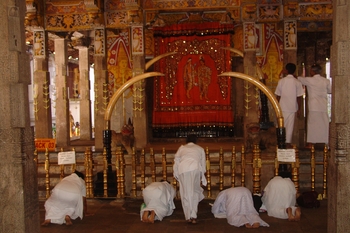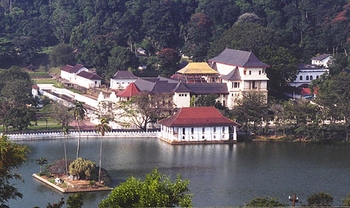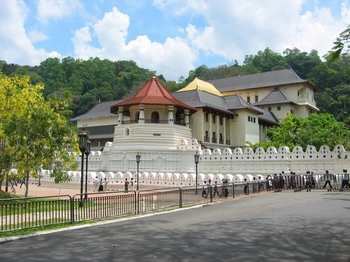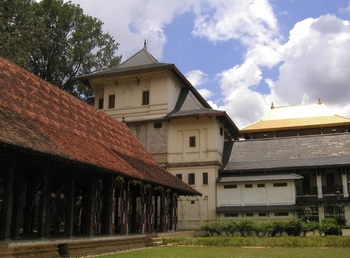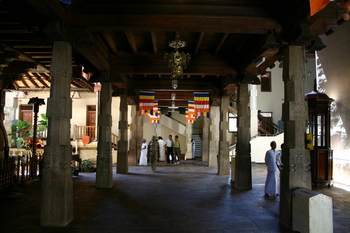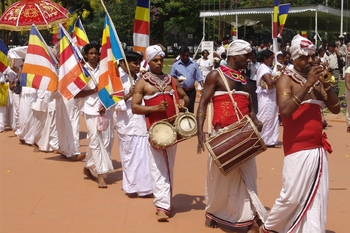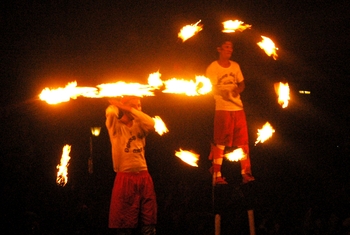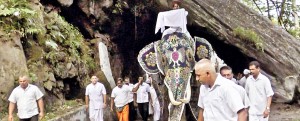
|
||||||||||||||||||||||||||
|
| ||||||||||||||||||||||||||
Ancient rituals at the ten-day Sri Dalada Esala Perahera, Kandy’s biggest pageant
By Udumbara UdugamaKandy’s biggest pageant, the Sri Dalada Esala perahera, is here again. The perahera begins on August 8 and continues for ten days, ending with the Daval (Day) perahera on August 18. There are five Kumbal and five Randoli peraheras. People take their young children to view the first Kumbal perahera believing it to bring them good health. The origins of the Dalada perahera date back to the time of King Kirthi Sri Meghavanna who received the Sacred Tooth Relic of the Buddha, brought from India by Princess Hemamala and Prince Danta, during his reign in Anuradhapura. The king commanded that the relic be taken around the city once a year with pomp and pageantry. It is this tradition that is continued, though it may have been interrupted due to wars and invasions. During King Kirti Sri Rajasinha’s rule in Kandy, the Dalada perahera joined with the four Devala perahera of the Natha, Vishnu, Kataragama and Pattini on a request made to the king by Maha Thera Upali from Siam who came to revive Upasampada (higher ordination).
The foremost ceremony of the Esala perahera is the ‘Kap’ situweema (planting of the Kapa) in the premises of the four Devalas. The Vishnu Devalaya also known as the Maha Devalaya plays a major role by having the responsibility of distributing the ‘Kap’ to the other three devalas. A ‘kapa’ is a stump cut from a tree which has a milky sap. It also means a dedication to the Gods, a vow and wish to make the perahera a success. The ‘Kapa’ is brought from Aluthnuwara, situated close to Mawanella on the Kandy-Colombo road. All rituals and activities are performed at auspicious times according to the Sinhala Almanac. The Maha Vishnu Devale Kapumahattaya, K.M. Varuna Bandara explained that on Tuesday, August 2 a ceremony was performed at an auspicious hour by the Wannaku Rala, (who is in charge of all activities in the Devale). Lighting nine pahan (oil lamps), placing nine varieties of flowers and reciting Astaka he cut the ‘Kapa’(a branch) from a sapling of a Jak tree, whilst five bhikkhus chanted pirith (religious stanzas). It was washed with saffron water and taken to the Aluthnuwara Dedimunda Devalaya to be blessed by the Kapumahattaya. Varuna Bandara who has Rajakariya – duty to perform rites at the Maha Vishnu Devale said that this year the ‘Kapa’ was ‘wedama kara’( brought) from Aluthnuwara on August 2 on a tusker. In the recent past, the ‘kapa’ was brought in a vehicle up to Raja Vidiya from where it was taken in a perahera to the Maha Vishnu Devalaya in Kandy. However, this year following an age-old custom the ‘Kapa’ was brought in a perahera all the way from Aluthnuwara, a distance of about 25 km on a tusker accompanied by hevisi (drummers) and flag bearers. The elephant, the drummers and flag bearers were changed every five kilometres, considering the distance they had to walk from Aluthnuwara to Kandy. The ‘Kapa’, which was brought to the Maha Vishnu Devalaya, was cut into four pieces of about one and a half feet in length, wrapped in cloth and distributed to the four Devales to be planted in the Esala Ge in the Devala premises. On Wednesday, August 3, each Devale planted the ‘Kapa’ at the auspicious time of 6.24 in the morning. For five consecutive days, rituals are performed in the Devale premises and on Monday, August 8, the first Kumbal perahera will parade the main streets of Kandy followed by four other peraheras. On Saturday 13th, the Randoli perahera which becomes longer with the addition of elephants, dancers and drummers, progresses to a magnificent spectacle. The Diyawadana Nilame walks behind the Maligawa Tusker carrying the Perahera Karanduwa (golden casket) followed by the Kandyan chiefs (Nilames) in their full regalia who walk in their respective Devala peraheras. On the first day of the Randoli perahera on August 13, members of the Adivasi community, men and women will come to the Dalada Maligawa bringing the Mee wada (honeycombs) packed in layers in Labuketa (dried gourds) to offer meepeni puja and pay their respects to the Sacred Tooth Relic. This Buddha pujawa was revived during the time of Uruwarige Tissa Hami Aththo, the then leader of the Adhivasi community. They arrive in time for the morning Tevava which begins at 9.30 a.m. and are taken into the Gandhakutiya, (inner chamber of the Sacred Relic). The Adivasi Nayaka Aththo – the Chief, hands over the honey to the main priest in charge of the Teva and they all offer flowers in worship. Thereafter, they are received in a hall by the Diyawadana Nilame and given refreshments and gifts of clothes. Arrangements are made for them to view the Randoli perahera that night from the Maha Maluwa, the premises near the Sri Dalada Maligawa. All expenses during their stay in Kandy are met by the Diyawadana Nilame. After Buddha attained Supreme Enlightenment, it is mentioned that two merchants, Thapassu and Bhalluka with 500 carts carrying goods had travelled through the Kiripalu forest when their carts stalled in the mud. They were informed by the Devas that Buddha was seated under a Kiripalu tree without food. The merchants prepared a delicious meal with honey and offered it to the Buddha. This is believed to be the first instance of honey being offered to the Buddha. It is also mentioned that when Buddha was in the Paraleiya forest, an elephant and a monkey had offered honey to the Buddha. On the last night of the Randoli perahera, the Maligawa tusker carries the Perahera Karanduwa to the Asgiriya Gedige Viharaya where it is kept overnight. A section of the four devala perahera proceed to the Getambe Thota for the water cutting ceremony at dawn in the Mahaweli river and returning to Kandy, leave the palanquins with the containers of water in the Pillayar Kovil in Katukelle. The following day the four Devala peraheras leave the Pillayar Kovil at about 2.30 in the afternoon and join with the Maligawa perahera, which leaves the Asgiriya Gedige Viharaya at the same time, to proceed along D.S. Senanayake Vidiya (Trincomalee Street), Raja Vidiya and finally end at the Maligawa. The four Devala peraheras return to their respective devalas, concluding the Esala perahera on August 18 this year. Courtesy: The Sunday Times (Colombo) of August 7th 2016
| ||||||||||||||||||||||||||
